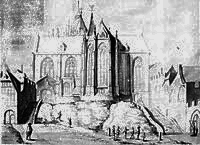St. Maria ad Gradus

St. Maria ad Gradus ("Our Lady of the Steps", also colloquially called Mariengraden in German language) is the name of a former church located East of the Cathedral of Cologne, Germany, situated between the cathedral and the Rhine.


Founded by Herman II, Archbishop of Cologne, the church was the burial site of blessed Richeza of Lotharingia (died March 1063), a former Queen of Poland and a grandchild of Otto II, Holy Roman Emperor and his wife Theophanu.[1] The Romanesque building, 55m long and 42m wide, was probably completed by Archbishop Anno II in 1075, when the relics of St. Agilulfus of Cologne (died 750) were transferred there. Already in 1080 it burned down, but was rebuilt in 1085 and later expanded.[2]
The remains of Richeza and others were later translated to the cathedral, which had been begun in 1248.[3] Konrad von Hochstaden was canon of St. Maria ad Gradus and Archbishop of Cologne at this time, from 1238 to 1261.
Following the French occupation of the Rhineland in 1794, monasteries and religious foundations were dissolved, and churches abandoned. As St. Maria ad Gradus was too close to other churches (the Cathedral, Great St. Martin's, and St. Andreas), it was partially demolished in 1817;[4] and most of what remained was removed in 1827 when the area was cleared to allow the Cathedral's restoration and completion. Only a few fragments remain.
Other burials[]
References[]
- ^ Ähnlich lag der Fall bei St. Mariengraden. Richeza starb 1063 wie ihr Vater Ezzo... in aller Pracht nach Köln überführen und in St. Mariengraden bestatten., Wilhelm Schorn, Albert Verbeek: Die Kirche St. Georg in Köln, 1940, p. 162, [1]
- ^ "Maria ad Gradus, which was completed in 1065, burned in 1080, rebuilt in 1085, and demolished in 1817. Under Archbishop Anno of Cologne (1056-1075) ..." – The Iconographic Encyclopedia of the Arts and Sciences, 1888, p. 156 [2]
- ^ Sabine Baring-Gould, Book of the Rhine from Cleve to Mainz, 1906
- ^ Die untergegangene Kölner Stiftskirche St. Mariengraden und ihre Geläute. ... zur künstlerischen Ausstattung und zum Geläute des 1817 abgebrochenen "Stifts" - AHF Jahrbuch der historischen Forschung, Berichtsjahr 2006, p. 363, Oldenbourg Wissenschaftsverlag 2007, ISBN 3-486-58360-3 [3]
External links[]
| Wikimedia Commons has media related to St. Maria ad Gradus (Köln). |
- Roman Catholic churches in Cologne
- Romanesque architecture in Germany
- 1817 disestablishments
- Burial sites of the Ezzonids
